The White House has lifted its summer ban on E15 gasoline sales for the fourth straight year. Starting May 1, gas stations across 33 states can sell this higher-ethanol blend that’s typically cheaper than regular gas. California still restricts it. Corn farmers are thrilled—more ethanol means more corn sales. Environmental groups? Not so much. They’re worried about air quality issues. The administration sees this as relief for summer travelers facing high fuel prices. More details ahead.
While summer typically brings restrictions on certain fuel blends, the EPA has officially lifted its seasonal ban on E15 gasoline across most of the nation. The emergency waiver, effective May 1, marks the fourth consecutive year such action has been taken. Pretty consistent for an “emergency” measure, right?
E15, containing 15% ethanol, was previously unavailable during summer months in roughly half the country due to concerns about increased smog formation in warm weather. Not anymore. The EPA has decided that fuel supply issues and keeping gas prices down trump those air quality worries. Priorities, people.
This decision impacts gas stations across 33 states, with over 4,100 locations now legally permitted to sell the higher-ethanol blend throughout summer. California remains the lone holdout, maintaining its state-level restrictions. They’re doing their own thing, as usual.
Corn farmers are celebrating. Ethanol comes primarily from corn, and this policy strengthens demand for their crops. Corn futures have wiggled a bit in response. The biofuel industry is touting environmental benefits too, claiming E15 reduces greenhouse gas emissions compared to conventional gasoline. Not everyone buys this argument. The reduced emissions claim has merit, as studies show corn ethanol produces 39% fewer emissions than conventional gasoline.
Critics exist. Environmental groups and some refiners have opposed expanded E15 use, pointing to infrastructure compatibility issues and questioning the air quality impact. This platform’s insights reveal that policymakers and analysts are closely monitoring these debates. The debate isn’t going anywhere soon.
The waiver effectively bypasses existing federal regulations on fuel volatility standards. Congress hasn’t managed to permanently allow summer E15 sales, so these annual emergency waivers have become the workaround solution. Elegant? No. Effective? Sure.
Consumers will notice more options at the pump and potentially lower prices. E15 typically costs less than standard gasoline. The administration is framing this as a win for energy independence and domestic manufacturing, while providing relief during high-demand summer driving months. The initiative aims to reduce the nation’s reliance on imported fuels while supporting American farmers.
Bottom line: your summer road trip just got another fuel option. Whether that’s good for your car or the environment remains debatable.
References
- https://subscriber.politicopro.com/article/eenews/2024/12/20/year-round-ethanol-a-victim-of-spending-bill-tussle-00195509
- https://ethanolproducer.com/articles/white-house-action-on-high-fuel-prices-ignores-e15-19131
- https://www.energyconnects.com/news/renewables/2025/april/trump-epa-approves-sales-of-high-ethanol-e15-gasoline-for-summer/
- https://www.law360.com/transportation/articles/2331116/epa-waiver-lifts-summer-ban-on-high-ethanol-fuel-sales
- https://www.eenews.net/articles/epa-allows-summertime-sales-for-e15-fuel/









